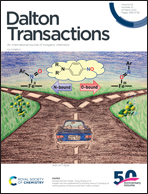The synthesis of a novel titanium oxide aerogel with highly enhanced removal of uranium and evaluation of the adsorption mechanism†
Abstract
A TiO2 aerogel with a high removal percentage and adsorption capacity was manufactured via template synthesis. Subsequently, the as-prepared TiO2 aerogel was characterized by various techniques and applied as an adsorbent for the removal of U(VI). The results revealed that the U(VI) adsorption was very rapid and reached apparent equilibrium within 100 min. The maximum removal percentage was 97.1%, which was calculated using the pseudo-second-order kinetic model (T = 298 K, t = 180 min, pH = 5, m/V = 0.1 g L−1 and C0 = 10 mg g−1). The Langmuir isotherm model was used to determine the maximum adsorption capacity and it achieved 638.0 mg g−1 (T = 298 K, pH = 5 and m/V = 0.1 g L−1). In addition, the removal of U(VI) on the TiO2 aerogel was relatively good in acidic solution and the removal behavior was independent of the influence of ionic strength. The removal percentage of the as-prepared TiO2 aerogel was higher than 90% after five cycles. Due to these excellent properties such as easy recovery, fast adsorption kinetics, high adsorption capacity and high removal percentage, the TiO2 aerogel might become an extremely employable adsorbent for the extraction of U(VI) in seawater.



 Please wait while we load your content...
Please wait while we load your content...